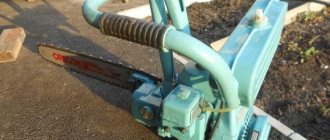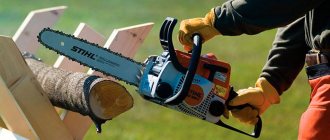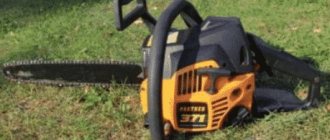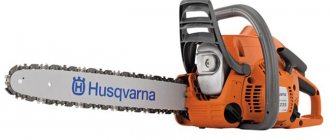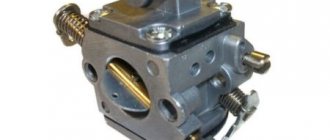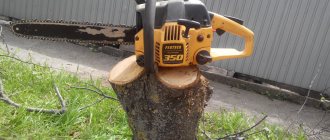Powered by gasoline | 07/26/2020
In some situations, owners of chainsaws may experience some confusion in understanding all the chain markings for these tools. As a result, this leads to unsuccessful purchases. The choice of chainsaws is often determined by just a few basic criteria, one of which is the chain pitch. This indicator helps to highlight the future capabilities of the tool, including its cutting speed, and according to standards it must correspond to the engine power level. How are chains marked? Let's figure it out!
Chainsaw chain markings
In some situations, owners of chainsaws may experience some confusion in understanding all the chain markings for these tools. As a result, this leads to unsuccessful purchases. The choice of chainsaws is often determined by just a few basic criteria, one of which is the chain pitch. This indicator helps to highlight the future capabilities of the tool, including its cutting speed, and according to standards it must correspond to the engine power level. How are chains marked? Let's figure it out!
How many links should there be in a bicycle chain?
I would like to dwell on one point. You can often hear the question: “How many links should there be in a bicycle chain?”
It is impossible to answer this unequivocally. There should be as many of them as needed for normal driving.
First of all, you need to clearly define what is meant by the term chain link.
As a reminder, all bicycle chains have the same full link size of one inch (25.4 mm) and therefore one half link of 1/2″ or 12.7 mm. And there are also Halflink chains (in English Half-link, where half is half, link is a link), in which the link length is 1/2″ (12.7 mm). This is discussed in the article on the design of a bicycle chain.
Therefore, the length of the chain depends on the type of bicycle frame, the size of the stays, etc. Typically road or hybrid bikes have 114 to 116 half links or slightly less. Mountain bikes have smaller frames and typically have 106 to 108 half-link chains or slightly larger. Well, how to correctly determine the chain length for your specific bicycle was described above.
If you need to know exactly how many links there are in the chain of your bicycle, there are two ways: simply count them or measure the length of the chain with a tape measure (centimeter) and divide this number expressed in mm by 25.4 - the length of one link (or 12.7 for a Halflink chain).
Basic circuit parameters
Chain marking requires the following parameters:
- Step:
- «0,325» - the most common and minimum step size, which is used in semi-professional and household chainsaws with low power. The standard power value for such a step ranges from “0.325” to “3 hp,” but not higher than “3.5 hp.” When working with this type of chain, cutting occurs more smoothly, comfortably, without “breaking” the workpiece.
- «0,375» («3/8») – applied to chainsaws with a power of “4 hp”. This chain is used when sawing wood of medium and small thickness.
The accuracy and quality of the cut created depends on the pitch value. In cases where it is not important to achieve high quality when working with a chainsaw, sometimes the accuracy of the cut is of particular importance. To do this, it is necessary to take into account the dependence of the step on the dissolution of wood according to pre-applied markings.
- The thickness of the leading links (tails). When a chainsaw is operating, its chain bears the majority of all loads. Taking this into account, another main characteristic of the operation of the saw is the thickness of the elements of the link that fits into the grooves of the bar. This parameter also determines the overall thickness of the fastening links, which is measured using a conventional caliper. Standard thickness values include:
- “1.1 mm” (“0.043”) and “1.3 mm” (“0.05”) are used in the production of entry-level chains that are intended for small amounts of work. Often, with such values of link thickness, the chain pitch length can be “0.325”, which implies the presence of low loads and a gentle operating mode. Therefore, they are used in household and semi-professional devices;
- “1.5 mm” (“0.058”) is the most common thickness value on the market for chainsaws and their accessories. This value can ensure safe operation with a step size of “3/8”. A 1.5mm thick chain is not intended for professional cutting;
- “1.6 mm” (0.063) and “2.0 mm” (0.08) - are intended for the most difficult work. The metal used in the manufacture of such chains is steel of special grades, and the design includes characteristics of increased strength.
The greater the thickness of the link and the wider the groove of the bar, the higher quality the chainsaw is considered, since it can withstand heavy loads.
- Cutting depth is a distinctive feature of the chains produced and is characterized by the profile height of the cutting teeth. It is measured by the gap between the stops and the cutting upper edge. Both high-profile (0.762 mm) and low-profile (0.635 mm) types of chain products can be presented on the market.
Number of links
When using one tire and a constant pitch value, the number of links in the chain must also be strictly observed during selection. If you make a mistake with this parameter, the chain simply cannot be put on - it will either dangle or be too small. Manufacturers usually indicate the number of links on the box. You can always clarify this parameter by phone if it is not possible to see the product in person.
In order to find out how many links there are in the chain of a particular chainsaw, you need to remove it and level it on the surface.
Counting is done by the leading links, that is, by the shanks that cling to the sprocket and protrude on the inside of the blade. There is no need to count all the links.
To avoid confusion and make your task easier, make a mark with a marker on the first shank counted. Having reached it, do not forget that you no longer need to count it. The number of elements can vary from 40 to 84. The most popular models are equipped with blades from 52 to 64 links long.
What does it consist of?
A modern saw chain is made of three types of links:
Working teeth are divided into left-handed and right-handed. The leading ones, also called shanks, are installed between the connecting and working ones with a certain pitch, which depends on the size of the links. Connecting, as the name implies, combines working and driving links.
There are two main types that can now be found on sale: chipper and chizzle chains. The division is based on individual parameters and the shape of the working tooth.
Chipper ones are more universal.
They can be used by both ordinary users for work at home, and by professionals for longitudinal sawing. Most often, professionals use saw chains of this type on chainsaws operating in LOGOSOL type sawmills. They, subject to the required sharpening angle (10 0 ), are able to quickly saw along the fibers, which is the most important thing in a sawmill, while their performance and high productivity are maintained for a long time. If necessary, chains of this type, like others, can be sharpened using a file or sharpening machine.
Chisel - show greater productivity when cutting crosswise.
Used by professionals for felling and bucking. The angles of attack of such a chain are aggressive, it cuts easily and cuts quickly, but only across the grain. The cutting speed along the length, even with proper sharpening, is lower for such a headset.
Below is a video about the types of chains and selection criteria for a chainsaw. It describes in detail the main parameters of the headset. Shows what links of different types and sizes look like. Much attention is paid to pitch and width.
Special
A separate type of chains for chainsaws are carbide, special purpose. These include chains for cutting concrete, aerated concrete or emergency rescue work. The design of the tooth in such a set includes pobedite soldering, which allows you to saw concrete, thin metal, reinforcement, and glass.
Such chains are very expensive. It is not advisable for the average user to buy them.
Areas of use of chainsaws
Before deciding which brand of chainsaw to choose, you need to consider the areas of its subsequent use. The undeniable advantage of a chain saw is, first of all, its versatility and mobility. Regardless of the manufacturer and model, the saw can be used:
- Foresters for forest clearing and tree felling;
- Roofers for sawing building materials;
- Owners of country houses and dachas for the purpose of erecting small structures made of timber (baths, gazebos);
- Sculptors to create artistic forms from wood, ice and other materials;
Which is better
We've sorted out the parameters, now let's see which chain for a chainsaw is better and why. This question is relevant, because... everyone wants to use only the best, but what criteria are used to determine which chain is better and which is worse? Does better mean faster, or does better mean safer?
All types have both advantages and disadvantages. For example, a chisel with a seat size of 1.5 mm and a pitch of 0.404 inches is the most dangerous. It has high recoil and is difficult to control, but at the same time, it differs from others in terms of better cutting speed and productivity.
We think that it is up to the consumer to decide which chainsaw chain is better and which is worse, based on his own experience. We can only talk about the facts.
Chain (1.6 mm; 64 links; 0.404″) for saws Ural, Druzhba Rezer ACS-10-1,6-64
The Rezer ACS-10-1,6-64 universal chain is used with chain saws Ural, Druzhba 404. Recommended for intensive work on felling, bucking, construction of wooden structures, cutting wood. Creates low vibration due to the special design of the middle links, as well as low noise and recoil. The cutting teeth are made of special steel, their geometry allows for a soft, even and clean cut. It must be remembered that for the chain to function properly and increase its service life, it requires constant lubrication and sharpening. For sharpening, a file with a diameter of 5.5 mm is required.
How to choose
The selection issue is relevant for inexperienced users. Professionals know almost everything about the headset and know how to choose what they need. For this reason, our advice will be aimed specifically at amateurs, and not at pros. So let's get started.
In order to choose correctly you need:
- Know the characteristics of the chainsaw, namely the pitch and length of the bar. When choosing, you should not rely on the name and model of the chainsaw, because... One chainsaw can be equipped with tires of different lengths and seat widths.
- Decide in advance on the volume and type of work for which you plan to use it. If you cut across, we choose chisel ones; if we cut along, we choose chipper ones.
Important! You will have to sharpen it for a longitudinal cut (10 0) yourself or at a service center. A headset sharpened for longitudinal cutting is rarely found on sale.
Separately, it is necessary to mention the choice of the Shtil headset. If you are planning to buy a chain from this manufacturer (they are considered the highest quality today), then to make your choice it is better to use a special search form, which can be found on the company’s website.
By entering the chainsaw data into the search form, the program will automatically select and offer you suitable options. The service is convenient, but has one big drawback: selection is carried out only according to Shtil chainsaw models. In order to select a chain for saws of other brands, you will have to arm yourself with a catalog.
Discussions
Found an error in the description?
© 2006 — 2022. VseInstruments.ru
Email Tel. (from 07:00 to 22:00) 8 (from 07:00 to 22:00) The call is free
All information on the site is the property of the online store Vseinstrumenti.ru. Publishing information from the website vseinstrumenti.ru without permission is prohibited. All rights reserved.
The information on the website www.vseinstrumenti.ru is not a public offer. The indicated prices are valid only when placing an order through the online store www.vseinstrumenti.ru.
Prices at delivery points and retail stores of VseInstrumenty.ru may differ from those indicated on the website.
You accept the terms of the privacy policy and user agreement every time you leave your data in any feedback form on the VseInstrumenty.ru website.
Source: www.vseinstrumenti.ru
How to count links
Many users do not know how to correctly count the number of chain links, although this is done quite simply. It is better to count by the shanks. In order not to get lost when counting, the shank from which you start counting needs to be marked. This can be done with a marker or by gluing a piece of paper on it.
The second calculation option is to count the number of connecting links. It is faster to count in pairs; to do this, you need to unwind the chain, fold it in half and lay it out on a flat surface, for example, on a table.
Important! When counting, it is not critical to be off by one link. If one link is missing, then when choosing and purchasing a spare chain, you can make a mistake and purchase a short chain, which will be impossible to install on a chainsaw.
Chainsaw structure and operating principle
Regardless of the manufacturer, power and purpose, modern chainsaws consist of the following main components and assemblies:
- Engine (two- or four-stroke);
- Transmission (mechanism for transmitting rotational motion from the crankshaft to the drive coupling);
- Guide bar for placing the chain;
- Plastic protection, tanks for filling fuel and lubricant;
- Handle with throttle control button.
https://www.youtube.com/watch?v=
When the starter handle is pulled sharply, a spark is created that ignites the air-fuel mixture passing through the carburetor damper. As a result of its combustion, strong pressure is created on the piston, which causes the engine crankshaft to rotate in a reciprocating motion. After turning off the motor, the spark disappears and the saw stalls.
Most modern chainsaws are equipped with an automatic friction clutch, which eliminates chain movement when idling. Thanks to this solution, it is possible to avoid injuries during operation of the unit. If the tire gets stuck while sawing wood, the friction clutch slows down the engine speed until it stops completely.
How to find out what type of headset is on a chainsaw
There are several ways to determine the type of chain that is installed on a chainsaw. If the saw is new, just purchased, then the type and size of the chain are indicated in the documents (user manual, in the characteristics section). If the saw has already had time to work and it is not known whether the headset has changed during operation, then you can determine the type of chain by performing the following steps:
- Remove the headset and count the number of links.
- Using a caliper, measure the width of the shank.
- Visually determine the type of cutting tooth. Sharp side edges are chisel, smooth edges are chipper.
- Use a ruler or caliper to measure the chain pitch.
Why do you need a table that determines the sizes of chains?
The reasons that reduce the productivity of saws with an internal combustion engine are incorrect selection of size, profile height and chain pitch. When purchasing it, you need to carefully study the markings on the closing links, as well as the performance characteristics indicated on the packaging. If it is impossible to decipher the marking and there is no packaging for the product, the best way is to select the product according to the size table. They can be found on the official websites of well-known manufacturers, such as Uskvarna, Shtil, Oregon. Let's look at these tables that will help you choose the right size chain for your chainsaw. The left column contains the most common models of chain saws in our country. The following columns contain the main parameters of saw units. Once you find the right model, you will quickly find out which chain will fit your tool. For chainsaws produced by one company, chains produced by other companies may be suitable.
Size chart for Stihl chainsaws
| Model | Step | Cutting depth | Tire length | Number of links | Product from Stihl | Husqvarna chain |
| MS 180, 230, 250 | 3/8 | 0.013 cm | 0.3 meters | 55 | 63 PM 50 /55 | H 3550 /55 |
| MS 260, 280 | 0,325 | 0.016 cm | 0.38 / 0.4 meters | 62 | 26 RMC 62 /67 | H 2562 / 67 |
| MS 650, 880 | 0,404 | 0.016 cm | 0.4 / 1.5 meters | 60 / 173 |
Size chart for Husqvarna saws
| Model | Step | Cutting depth | Tire length | Product from Stihl | Chain made by Husqvarna | Oregon product |
| 236 | 3/8 | 0.013 cm | 0.35 meters | 63 PM 52 | H 3552 | 91P52 |
| 137, 235, 345, 353, 440, 450 | 0,325 | 0.013 cm | 0.38 meters | 23 RMC 64 | H 3064 | 95VPX 64 |
| 262, 272, 365, 395, 570, 576 | 3/8 | 0.013 cm | 0.45 / 0.5 meters | RM35 68 / 72 | H 42 68 / 72 | 73LPX68/72 |
| 55, 257, 359, 460, 555 | 0,325 | 0.015 cm | 0.38 meters | 25 RMC 64 | H 25 64 | 21 LPX 64 |
| 3120 | 0,404 | 0.016 cm | 0.61 meters | RM46 76 | H 6476 | 59 L 76 |
Chain Definition Chart for Champion Tools
| Model | Step | Cutting depth | Tire length | Chain made by Stihl | Husqvarna product | Oregon chain |
| 137, 240 | 3/8 | 0.013 cm | 0.4 meters | 63 PM 56 | H 3556 | 91 VXL 52 |
| 55, 250 | 0,325 | 0.013 cm | 0.45 meters | 25 RMC 72 | H 2372 | 20 LPX 72 |
| 254 | 0,325 | 0.015 cm | 0.45 meters | 26 RMC 72 | H 25 72 | 21 LPX 72 |
In conclusion of the article, it must be said that the correct selection of chain products is an important task that increases the performance of a chainsaw and increases its service life. Using the size chart, you will buy the right chain of good quality.
Everything you need to know about the numbers on a chainsaw bar?
Good day, dear readers!
The dacha and construction season is gaining momentum in some places, and in some places it has been in full swing for several months now. And at this time, certain instruments are gaining particular popularity. One of them is a chainsaw. We'll talk about what the tool is another time.
In the meantime, I want to tell
you everything you need to know about the numbers on the chainsaw tire.
Tire
, to put it in simple and understandable language, is a metal plate with a recess along the entire area.
Plate shape: oval flat.
To put it even more simply, the tire is what the chain rests on and rotates.
.
WHAT YOU NEED TO KNOW ABOUT TIRE MARKINGS
Just a few main points:
The more links, the longer the chain. popular values: 50, 52, 55, 56, 57, 62.
The pitch shows how far a chain link is from another link. The more often the tooth, the cleaner and longer it will cut.
The thickness of the chain affects the performance of the saw. But the thicker the chain, the more powerful the tool should be.
The length of the bar determines how far the chain can cut. Again, longer bars are used on more powerful saws.
From high-quality and professional: OREGON (USA), STIHL (Germany). From household ones: CHAMPION, for example.
By and large, this is all you need to know to choose the right tire and chain for it.
Let's look at the meaning of each item using an example.
This is “embossed” on the tire itself. But for greater convenience, sometimes the main values are written on the box or cardboard insert. An example is shown below.
So, all the values in order:
- 16′
is 16 inches or
45 centimeters
- the length of the tire. - 0.50′
or
1.3mm
indicates the thickness of the chain and, accordingly, the recess for the chain on the bar. - 3/8
or
0.375
is the chain pitch (the distance between the riveted places of the chain) - 56
is the number of chain links. Measured on the inside of the chain.
Below the number of teeth on the sprocket has been added - 9T
.
These are the basic values you need to know.
If you liked my article, please like it. And also subscribe to the channel.
Classification of saw bars
A saw set refers to the working elements of a chainsaw, which are intended for direct cutting: a chain and a bar.
One of the points that influence the choice of a particular model is the type of tire and its length. Saw bars for chainsaws are classified as follows:
- narrow flat - works in tandem with a low-profile chain of a non-professional household chainsaw, minimizes the risk of injury due to the virtual absence of the “kickback” effect, which is especially important for chainsaw beginners;
- lightweight - made of two steel plates connected by a polyamide layer. This design significantly reduces the overall weight of the chainsaw itself, which can serve as a serious advantage when performing certain types of work;
- bar with replaceable head - installed on professional chainsaws of medium and high power, used for a large volume of long-term work.
Tire type is a serious characteristic, but not the only one that needs to be taken into account when purchasing a chainsaw.
Design of traditional bicycle chains
The two inner plates in a traditional bicycle chain are connected to each other by a glass (bushing) - it is similar to a hollow axle. If you disassemble a link of such a chain, you can see the flared edge of the glass outside the inner plates.
When assembled, the outer plates cover the glass - its outer part is also not visible, it is covered by a roller. The rivets that connect the chain plates pass inside the glasses, the rollers are outside. In this case, the inner and outer sides of the glass are subject to wear.
Chains without glasses
In such bicycle chains, the internal plates are not flat. Instead of the usual hole for pressing the glass, each hole in the inner plate has an annular protrusion half the internal width of the chain. The edge of this protrusion is chamfered, allowing the chain to move more smoothly when misaligned than a traditional bicycle chain. Perhaps because of this, switching is also easier. Due to the fact that the “glass” in a chain without a glass consists of two halves that are not directly connected to each other, such a chain bends better in the transverse direction - there is a small gap between the halves of the “glass”.
Lubrication points
I believe that the main reason for the increased life of chains without cups is better lubrication of the chain in its vulnerable areas.
There are three points where the lubricant should be. The first and most important point is where the rivets rub against the inner plates as the chain links rotate relative to each other. The second is the inner surface of the roller; lubricant in this place ensures free rotation of the roller when it hits the teeth and when it comes off them.
When the roller does not rotate, it slides along the teeth and causes increased wear on the sprockets. The third point is where the outer and inner plates meet, although the point of contact is much less loaded than other places.
In traditional bicycle chains, in order for the oil to get to the rivet, it needs to pass inside the glass between the inner and outer plates. If you use a spray, the oil penetrates into the link from both sides at the same time. Air remaining inside the glass can clog the inlet for further lubrication. In addition, road dust gets into the open space between the inner and outer plates and heavily contaminates the chain. Therefore, if oil does get inside the glass, it will already be contaminated.
In chains without cups, lubricant gets in differently. When oil hits the roller, it seeps in from both sides and displaces air through the gap between the two halves of the glass. Having dripped oil on such a chain only onto the roller, it gets onto the inner surface of the roller and onto the rivet, and along it to the gaps between the plates. Since the side plates are lubricated from the inside, the flow of lubricant washes dirt out. The chain rollers clean themselves when they come into contact with the sprocket teeth.
Sheldon Brown
More reading on this topic:
Bicycle chain links sticking. It happens that when riding a bicycle, you regularly feel that the pedals are skipping or jerking every three or four revolutions. This suggests that...
Bicycle chain slipping. Chain slippage causes one of two unrelated phenomena - direct slippage and spontaneous gear shifting. The main thing to solve the problem is to determine what exactly happens from the two cases...
Bicycle chain wear. We take a section of a chain with the number of links in it - 20. Multiplying the number of links by the length of a standard link of 12.7 mm, we obtain the size of a section of a new chain of 20 links equal to 254 mm. We take a ruler and measure...
Bicycle block chain. In the late 70s, blockchains finally disappeared from sale. These were replaced by modern 1/2" pitch, 3/32" wide chains that were used with derailleurs. But track cyclists still preferred to use wider chains...
Bicycle chain device
Any bicycle chain (except Half-Link) consists of several elements, namely:
- Outer link plate.
- Inner plate.
- Video clip.
- Bushing (glass).
- Pin.
- Complete chain link.
- Gap for side bending.
1 link consists of 2 half-links. They are connected to each other using a pin placed in the “glass”. A roller is put on it. The roller is necessary to hold the bicycle sprockets on the teeth (where the chain is put on). The length of one full link is 1 inch, which translates to 25.4 millimeters. The length of the entire chain is determined by how many links it contains.
For a 12-speed adult bicycle, a 126-link chain is typically used. There are many variations, the number of links varies from 110 to 126 pieces. Mountain bikes (MTB) use 106 or 108 chainstays.
If after purchase it turns out that the chain is too long, it can be shortened. This is done by disconnecting the lock (if there is one) and knocking out the pin. After that, everything is connected back together and installed on the bike. This way you can adjust a chain that is too long to fit your bike.
What it is
To improve the quality of the cut, as well as extend the period from one sharpening to another, carbide chains were invented. The use of hard alloys in wood sawing is not new. Composite bonding technology has long been successfully used in the production of circular saw blades.
The carbide chain is not homogeneous in its structure. It is a combination of two metals: ordinary tool steel and a special alloy of increased hardness. The first one is used to make driving, cutting and connecting links, as well as rivets. The alloy is applied to the cutting edge and the upper plane of the working link in the form of a thin plate. Fastening method: soldering. This means. that copper-nickel and copper-brass solders are used to connect the solid part and the steel base. The choice of these particular materials is not accidental: they have good fluidity, adhesion, and also have a melting point that is approximately 300 degrees different from the operating heating of the chain. That is why you should not overheat the saw set.
Pobedit is the popular name for alloys based on tungsten carbide, which makes up up to 90% of the total mass of the substance. The remaining 10% is cobalt, which is needed as a binder, and just a little carbon. In fact, tungsten carbide is a cermet material that is extremely hard and has excellent temperature resistance.
There are several types of chains
Chain for single-speed bicycles (Single-speed)
As the name implies, it is used on single-speed city bicycles without gear shifting, on children's and teenage bicycles, as well as on bicycles with a planetary hub. These bikes have a single sprocket on the rear wheel, and gear shifting occurs inside the rear hub.
With proper use, a single-speed chain practically does not wear out to the point of complete “death” and “lives” as long as the bicycle itself. This is because the chain on a single-speed bicycle is a straight line from the front to the rear sprocket and does not experience the lateral bending stresses of multi-speed bicycles.
They are made from thicker and, accordingly, stronger and stiffer plates, and are subjected to thermal and chemical treatment to increase wear resistance.
Please note that the teeth of single-speed sprockets grip the chain link to the full height of the roller and hold it more tightly. The load on the roller is uniform and constant. This is one of the reasons why they practically do not stretch, unlike multi-speed bicycle chains
This is one of the reasons why they have virtually no stretch, unlike multi-speed bicycle chains.
Single-speed chain width, measured as the distance between the inner link plates, is from 8.7 to 11.0 mm.
By the way, the efficiency of pedaling on a straight chain is higher than on a skewed multi-speed chain - there is no energy loss to overcome the friction that occurs when it bends.
Chain for multi-speed bicycles
Multi-speed bicycle chain is designed for bicycles with gear shifting. It differs from single-speed in the presence of a gap between the link plates. It allows the chain to bend sideways (see picture above). They are also usually smaller in width, since the thickness of the cassette chainrings on shift-shift bikes is smaller than on single-speed models.
Please note that the teeth of the cassette sprockets and front sprockets on multi-speed bicycles do not grip the chain link to the full height of the roller, but approximately half. Their teeth are lower, since the chain jumps from one sprocket to another when changing gears. Because of this, the load on the chain rollers is not as uniform as on single-speed models
Because of this, the load on the chain rollers is not as uniform as on single-speed models.
In the article “What are the gears (speeds) of a bicycle and how to change them”, recommended and not recommended options for switching gears have already been mentioned. They are caused by severe misalignment of the chain, which leads to rapid wear not only of the chain itself, but also of the rear (on the cassette) and front (in the system) sprockets. Let's look at these options again:
The chain of a multi-speed bicycle is almost always misaligned, which reduces pedaling efficiency and leads to wear on the transmission elements: chain, front and rear sprockets.
Just like the previous type, they consist of internal and external links.
Lightweight bicycle chains.
They have hollow pins and perforations in the plates.
They are often 20-25 percent lighter than their standard counterparts, but are also more expensive and less durable. Used by cyclists who fight for every gram of excess weight. These are mostly racers.
Due to their design features, such bicycle chains stretch more and are generally not as strong as the types discussed above.
4. Half-link bicycle chains
Chains with one repeating link are called Half-link chains (in English Half-link, where half is half, link is link).
The peculiarity here is that they do not have internal and external links, and all links are the same. The length of the link is 1/2″ (12.7 mm). They are easier to adjust to the desired length, because... You can shorten one link at a time. However, operating experience shows that due to the design features, they tear more often and stretch more strongly.
